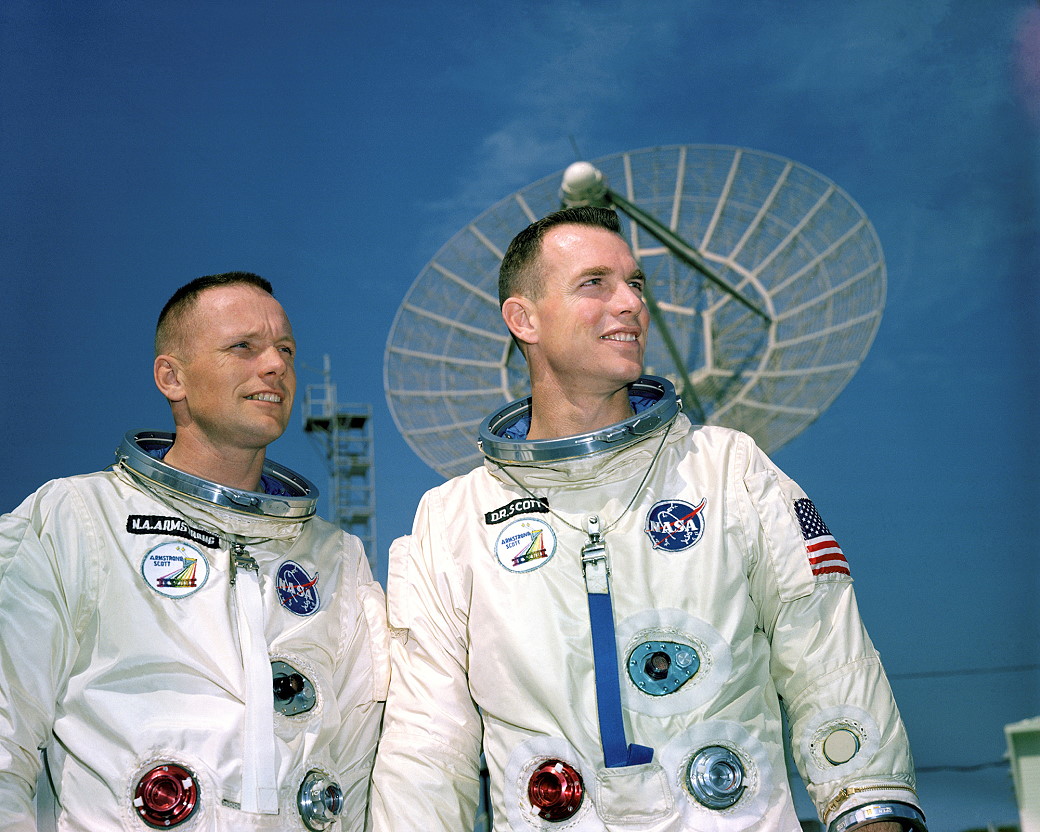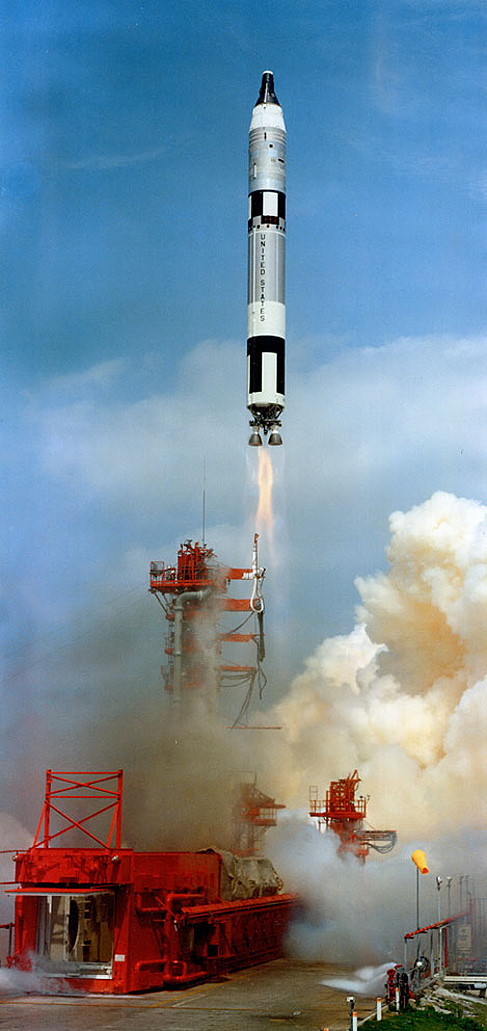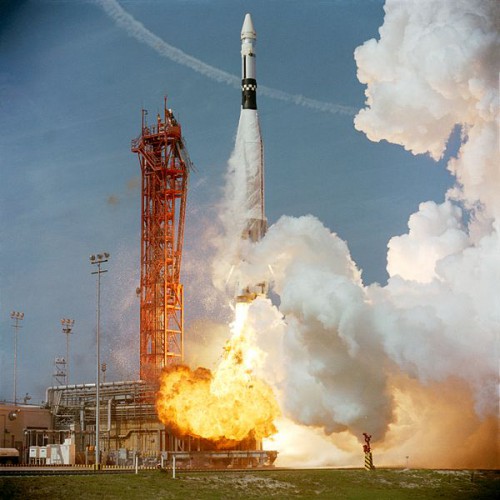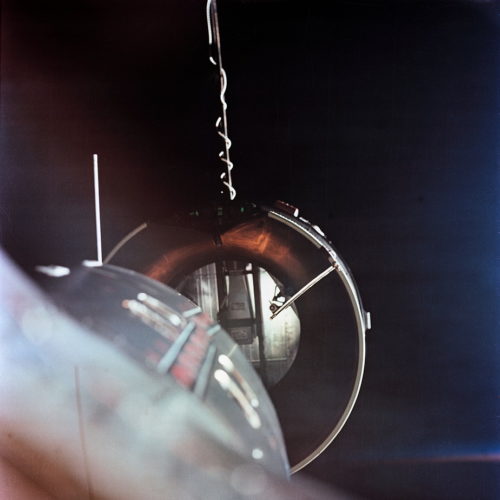
At the dawn of 1966, America’s drive to land a man on the Moon had accelerated into high gear. Five Gemini crews had shown that astronauts could survive in space for long enough to complete the journey and that it was possible to venture outside in a pressurized suit and perfect the tricky technique of orbital rendezvous—all of which would someday be critical in enabling the first steps on another world. On Gemini VIII in March 1966, astronauts Neil Armstrong and Dave Scott sought to press the envelope still further. They would spend three days in space, perform rendezvous and—for the first time—actual physical docking with another object, and execute combined maneuvers, scientific experiments, a two-hour EVA, and a precision re-entry and splashdown. In time, Armstrong and Scott would both leave their bootprints on the dusty lunar surface … yet their ill-fated flight together on Gemini VIII would bring them within a whisker of losing their lives.
The pair had been together since the end of August 1965, and neither man was under any illusion about the complexity of their task. The EVA was particularly crucial. Unlike America’s first spacewalker, Ed White, who had moved around for barely a few minutes, Dave Scott would maneuver to the rear of Gemini VIII, reverse himself into a backpack, known as the Extravehicular Support Package (ESP), and attach a tether to enable him to venture up to 90 feet away. He would spacewalk through orbital daytime and nighttime, retrieve an emulsion package, activate a micrometeoroid collector on the Agena target spacecraft, and test a reactionless power wrench. It was only the second time an American had left his craft in space, and Scott’s work was laden with risk; if he hit difficulties, there would be no way for Armstrong to see or reach him. Aware of this risk, Armstrong had requested realistic training models of the Gemini’s aft adaptor section and a series of rehearsals in an altitude chamber. By the eve of launch, Scott had practiced his movements on 200 parabolic aircraft flights and more than 20 hours on an air-bearing table.
Scott knew that to operate effectively within a space suit he needed to maintain his physical fitness and strength. This was particularly true from conversations with Ed White, who had experienced difficulty closing the Gemini’s hatch at the end of his own EVA. A lever had been fitted to make it a bit easier, but White cautioned Scott that the suit was stiff and heavy and demanded enormous reserves of stamina for any movement, let alone two hours of physical work. Scott jogged, played handball, and pumped iron in the gym, and this brought him face to face with Neil Armstrong’s wry humor. When it came to physical exertion, Armstrong had one cardinal rule: Human beings had a finite number of heartbeats and should not waste them with frivolity! One day, during Gemini VIII training, as a sweat-drenched Scott worked out, Armstrong set the exercise bicycle on its lowest possible setting and began pedaling. …

The training uncovered obstacles that might have threatened Scott’s life. The air-bearing table, for example, allowed him to literally “fly” across a surface and demonstrate a hand-held maneuvering gun. The gun was filled with Freon, a relatively dense refrigerant, and the strength of its impulse caused Scott to worry about how it might perform in space. In one test at low temperatures, the Freon caused the gun’s poppet valve to stick “open” when triggered. Had this occurred in the frigid cold of orbital flight, the escaping gas might have caused Scott to tumble uncontrollably. Elsewhere, there were concerns that an injector in the space suit’s chest pack might freeze and prevent the flow of oxygen, and trials inside the cramped Gemini cabin left some engineers literally “tangling” with the problem of a jumble of floating umbilicals, tethers, and jumper cables. Not until December 1965 did Scott feel confident that he could complete the task.
On the morning of 16 March 1966, the two astronauts awoke in their crew quarters at Cape Kennedy and breakfasted on filet mignon, eggs, and toast with butter and jelly. The skies above Cape Kennedy were clear, blue, and cloud-speckled, and conditions seemed perfect for the launch of their Agena-D target vehicle—a pencil-shaped craft, mounted atop an Atlas rocket—at 10:00 a.m. EST and their own launch at 11:40 a.m. As they donned their suits, a watch belonging to aviation pioneer Jimmy Mattern was strapped around Armstrong’s wrist, and pieces of wood and cloth from an old Douglas World Cruiser, the New Orleans, were packed with Scott’s personal effects. Both were on loan from the museum at Wright-Patterson Air Force Base. At Pad 19, where Gemini VIII sat atop its Titan II booster, a glitch with Scott’s parachute harness required backup commander Charles “Pete” Conrad to ferret around for a toothpick to remove epoxy resin from the catcher mechanism.
As the clock struck 10, the Atlas-Agena combination thundered away from Pad 14, inserting the vehicle perfectly into orbit. By now alone in the cramped cabin of Gemini VIII, the astronauts were elated. The first stage of their mission was running smoothly. “Cradled in my contoured seat,” Dave Scott wrote in his autobiography, Two Sides of the Moon, “it felt almost as if I was being held in someone’s arms.” The Gemini felt as snug and crisp as a brand-new Ferrari, and the pure oxygen atmosphere provided a cool sense of freshness and cleanness to the cabin.
Under the direction of Flight Director John Hodge, Gemini VIII itself rose from the pad at 11:41 a.m. The astronauts felt “a solid feeling, a sharp kick in the tail” as the Titan delivered them smoothly into space. Scott’s heart rate peaked at 128 beats per minute, with Armstrong’s reaching 146; post-mission analysis would determine that the difference was attributable to a “keying-up” of the commander’s physical and psychological awareness, rather than an indicator of undue stress. Armstrong told his biographer, James Hansen, that the ascent was “very definite” and that although the Titan’s thrust was noticeable, it did not interfere with their communications. By the time the first stage separated and the second stage ignited, Scott described the ride as “smooth as glass” and, minutes later, was amused to let go of his checklist and watch it drift across the cabin … together with a small metal washer which hovered in front of his face.
Nothing could have prepared either man for his first glimpse of Earth. By now they had crossed the vast gulf of the Atlantic Ocean, and as Armstrong rolled Gemini VIII they beheld the deep trench of the Mediterranean Sea, with Italy clearly visible, and far on the horizon the unmistakable shapes of the Middle East and the Red Sea. In those euphoric seconds, Scott realised that his camera would do no justice to this scene; privately he hoped that NASA would someday send an artist or a poet into orbit to describe it better. Nonetheless, he broke out his camera and starting shooting. Armstrong, too, was overwhelmed. He had flown the X-15 rocket aircraft to an altitude of more than 40 miles (64 km) and had seen the curvature of the Home Planet, but this was four times higher and something quite different.

There was little time to gaze in wonder at the astonishing scene. Armstrong and Scott were trailing the Agena by a little over 1,000 miles (1,600 km), and they were scheduled to rendezvous and dock with it, later that same day, before performing the EVA. Ninety minutes into the mission, they fired Gemini VIII’s thrusters to slightly lower their orbital apogee. A second burn raised their perigee and a third, at 2:27 p.m., placed them into roughly the same orbital plane as the Agena. “A fundamental requirement of rendezvous,” Armstrong told Hansen, “is to get your orbit into the same plane as the target’s orbit, because if you’re misaligned by even a few degrees, your spacecraft won’t have enough fuel to get to its rendezvous target.” By launching in a tightly defined time span and entering orbit within a few tenths of a degree of the target, Gemini VIII was thus poised. Betwixt the thrusters burns, Armstrong and Scott broke for lunch … and broke would probably be an apt choice of word. Space food was hardly home cooking. The chicken and gravy casserole, despite having been rehydrated, was quite dry, and the men’s chocolate brownie cookies stuck together and crumbled apart. Fortunately, they were running on reserves of adrenaline and eating was the last thing on their mind.
At length, the Agena was detected by radar at a distance of about 200 miles (320 km), and another burn of Gemini VIII’s thrusters, high above Madagascar, aligned them with perfection for the “terminal” phase of the rendezvous. An hour later, at 4:21 p.m., Scott visually sighted the target, less than 80 miles (130 km) away, its rendezvous beacon blinking against the black sky. Drifting into orbital nighttime, they lost sight of it for a while, although its beacon was still apparent, and when they re-established visual contact Armstrong prepared for docking. He was now braking Gemini VIII by eyesight alone, firing off short spurts of the thrusters … and, at length, the men’s craft came into position, close to the Agena, with no relative velocity. Thirty minutes later, after checking that the target was undamaged, they prepared to move in for the final rendezvous and docking.

The complexity and importance of this maneuver cannot be underestimated. No previous physical docking had ever been accomplished by a manned craft, and, with NASA planning Lunar Orbital Rendezvous as part of its scheme to land on the Moon, the work of Armstrong and Scott was absolutely critical. As the commander guided his ship gingerly closer, he experienced no problems; in fact, fellow astronaut Wally Schirra—who performed a rendezvous the previous December—had assured him that flying close to another vehicle was very easy when the correct positioning had been achieved. For 25 minutes, Armstrong and Scott electronically checked the Agena’s systems, antennas, and lights by radio command and by now were so close that they could read a small instrument panel above its docking collar. At 6:15 p.m., less than seven hours after launch, Armstrong became the first human being to dock with another craft in orbit. An electronic motor aboard the Agena retracted the collar, pulled the Gemini’s nose into the target, and connected their electrical systems. The instrument panel on the Agena displayed a green “rigid” confirmation.
Both vehicles were electrically and mechanically mated. They had done it.
“Flight, we are docked,” Armstrong announced, with more than a hint of triumph, “and it’s really a smoothie!” There was no noticeable oscillations in the combined craft. In the Mission Operations Control Room in Houston sheer pandemonium broke out. The achievement of Gemini VIII had cleared another hurdle on the road to the Moon.
Armstrong’s “smoothie,” though, would be the last time that anyone on the ground or in orbit would breathe easily. Within minutes, Gemini VIII would change from a perfect flight into a very real battle for survival.
The second part of this article will appear tomorrow.
Want to keep up-to-date with all things space? Be sure to “Like” AmericaSpace on Facebook and follow us on Twitter: @AmericaSpace
Missions » Apollo »



I love everything about the Gemini missions, they were all about pushing the envelope.
High risk high reward… or failure and the ultimate sacrifice.
This mission was saved by the steel edged nerve of men who “worked out the problem” showing no fear.
Truly wonderful.
If you want to build teamwork, you will definitely want to practice together,
of course. So strap on all your paintball load and gear up those paintball guns!
If” scenarios, and more, work on defensive and offensive strategies, code words, “what-.
Gain knowledge from the opposition in addition to your
very own teammates. Carefully notice other paintball athletes
to produce new and succeeding techniques for potential game titles.
Does the opposition crew talk greater than your team does?
Do they seem much more prepared? Focusing on the way your opponents work together can help increase your team’s performance.
Take a look at your opponents paintball gear and see if your team is lacking in that area.
This could significantly effect your gameplay